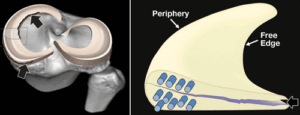Each knee has two menisci, a lateral and medial, which are situated between the femur (thigh bone) and tibia (shin bone). The menisci are fibrocartilaginous substances within the knee that improve force transmission and stability of the knee.
The Menisci function to improve:
- Force transmission through the knee
- Increased contact area decreases point loading of joint
- Improved Shock absorption
- The meniscus is more elastic than articular cartilage
- Improve joint stability of the knee.
- The meniscus deepens tibial surface and acts as secondary stabilizer
- In an ACL-deficient knee the menisci become the key stabilisers.
- The meniscus deepens tibial surface and acts as secondary stabilizer
At birth the meniscus has full vascularisation, but this decreases with age. By full maturation (adulthood), only the outer zone of the meniscus has a full blood supply (red-red zone) and the innermost part (white zone) has no blood supply.
The 3 Zones of the meniscus are the
- Red-Red Zone: Outer edge of Meniscus – Best Blood Supply
- Red-White Zone: Middle Zone of Meniscus – Minimal Blood Supply
- White-White Zone: Inner Zone of Meniscus – Nil Blood Supply
The amount of blood supply determines the healing capacity and therefore the inner white zone is susceptible to poor healing following acute trauma or degeneration.
Injuries to the meniscus can occur through an acute injury or degeneration. An acute tear occurs because of trauma often during sport and commonly following loaded twisting or bending motions. A degenerative meniscal tear occurs over time with gradual everyday load and age-related degeneration.
Meniscal tears can be treated with conservative therapy (Physiotherapy and Exercise Rehabilitation), surgical repair, or partial or complete menisectomy.
Meniscal Injuries are classified by the location, length, depth and pattern of the meniscus abnormality. This can be observed on MRI and arthroscopic investigation. Classifying the type of Meniscal lesion may assist with prognosis and determining appropriate management, whether this be surgical or conservative.
These are the common meniscus tear types:
Horizontal Tear
A horizontal tear runs parallel to the tibial plateau, and extends toward the periphery, dividing the meniscus into superior and inferior portions. I think of a sandwich, the location of the tear is horizontally between
- These tears usually occur in patients older than 40 years without an inciting trauma and are more common in the setting of underlying degenerative joint disease
Longitudinal Tear
Longitudinal tears run perpendicular to the tibial plateau and parallel to the long axis of the meniscus and divide the meniscus into central and peripheral halves (through the meniscus)
- These tears often occur in younger patients after significant knee trauma.
Radial Tear:
These are the most common meniscal tears, these tears are within the inner zone of the meniscus (which has poor blood supply/poor healing potential) towards the periphery. If this lesion causes locking of the joint or causes further joint irritation referral to Orthopaedic specialist for a potential partial meniscectomy (removal of the damaged meniscus) may be indicated.
Complex Tear:
A complex tear is one that tears in many different directions, and is often a combination of the different tear types all at once. These tears are often the cause of degenerative changes within the knee/meniscus.
Bucket-Handle Tear:
A bucket-handle tear is a large type of horizontal tear of the meniscus, with a central migration of the inner “handle” fragment. These types of tears often cause the knee to become stuck (known as locking) by causing the torn portion of the meniscus to block normal knee motion.
- 7x more frequently in Medial Meniscus compared to Lateral Meniscus.
If you would like some help with your knee injury or rehabilitation after a meniscal injury, our Physio’s here at Bend + Mend are happy to help! We have four locations in Sydney’s CBD and also offer Telehealth appointments.







